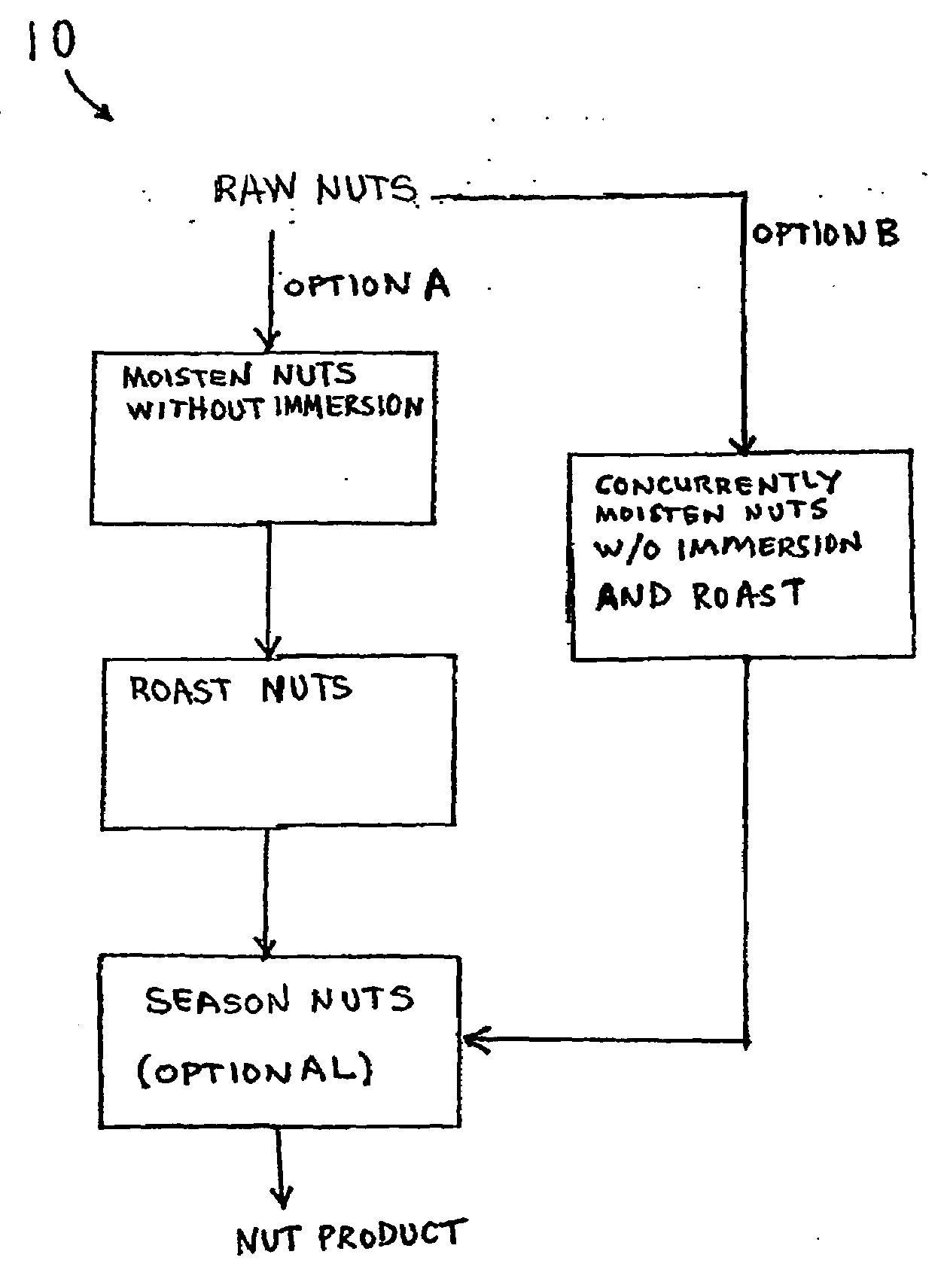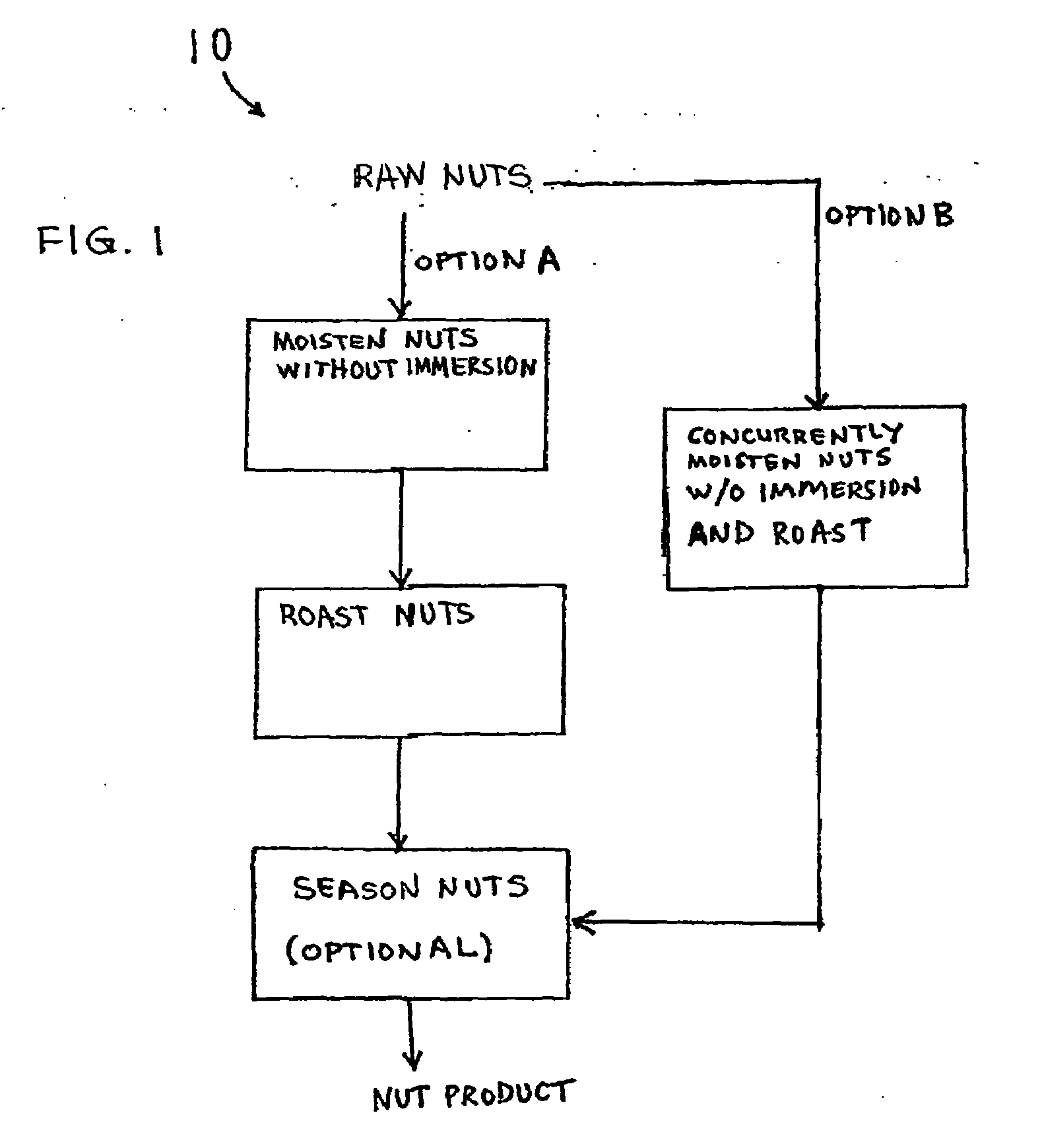Process to enhance flavor of roasted nuts and products with modified texture
a technology of roasted nuts and texture, applied in the field of roasted nuts, can solve the problems of affecting affecting and reducing the amount of roasted nuts, so as to improve the flavor of roasted nuts, reduce or eliminate the loss of flavor-forming compounds, and improve the quality of roasted nuts
- Summary
- Abstract
- Description
- Claims
- Application Information
AI Technical Summary
Benefits of technology
Problems solved by technology
Method used
Image
Examples
example 1
[0033]Twenty pounds of dry blanched peanuts (Runners) were added into a Cretors® coating tumbler (45° pan tilt angle, 28 rpm pan rotation speed). Fifteen hundred grams (total) of cold water (approx. 75° F.) was slowly added during tumbling in metered amounts (approx. 500 gram portions added at approximately 10 minute intervals) over a time period of approximately 30 minutes in a manner to effect wetting surfaces of the peanuts and such that no immersion of the nuts occurs. When the water was absorbed by the peanuts, the next dose (if any remaining) of water was introduced. Peanuts were not immersed or submerged in water. This treatment is referred to herein as a “wet pan” treatment. After adding all of the water, the wetted peanuts were discharged from the coating pan and oil roasted at 340° F. for 4 minutes. The roasted peanuts were cooled to about 100° F., and dressing oil and salt were added in typical proportions to the roasted nuts. As a control, a separate sample of the dry bl...
example 2
[0034]Additional samples of dry blanched peanuts (Runners)were subjected to a wet pan treatment similar to Example 1 except using the modified conditions detailed below.
[0035]As one additional sample, 3 lbs. water was added in a single addition to 16 lbs. peanuts as they were tumbled; the wetted nuts were tumbled and mixed in the coating pan for an additional 30 minutes; then the pre-wetted nuts were oil roasted at 340° F. for 4 minutes, and then cooled.
[0036]In yet another sample, 4 lbs. water was added in a single addition to 24 lbs. peanuts as they were tumbled; the wetted nuts were tumbled and mixed in the coating pan for an additional 20 minutes; then the pre-wetted nuts were oil roasted at 340° F. for 4 minutes, and then cooled.
[0037]In all these additional samples, the roasted nut products were crunchy and retained a rich peanut flavor.
example 3
[0038]Dry blanched peanuts (Runners) were moistened and roasted with high humidity, heated air at 350° F. and 75% humidity for a residence time of 7 minutes in a single stage operation. This operation was performed in a food treatment oven equipped with a vapor pervious conveyor, which transported the peanuts through a treatment chamber in which a stream of heated process vapor was circulated along the conveyor. The peanuts were substantially evenly spread in an unpiled manner upon the conveyor. The roasted nuts were discharged from the treatment chamber into a cooling chamber where they were allowed to equilibrate. The food treatment oven was commercially manufactured by Heat & Control, Inc., Hayward Calif. After cooling the roasted peanuts, standard dressing oil and salt was added to the roasted nuts. The product obtained was seasoned, dry roasted peanuts with crispy texture and enhanced roasted peanut taste.
PUM
 Login to View More
Login to View More Abstract
Description
Claims
Application Information
 Login to View More
Login to View More - R&D
- Intellectual Property
- Life Sciences
- Materials
- Tech Scout
- Unparalleled Data Quality
- Higher Quality Content
- 60% Fewer Hallucinations
Browse by: Latest US Patents, China's latest patents, Technical Efficacy Thesaurus, Application Domain, Technology Topic, Popular Technical Reports.
© 2025 PatSnap. All rights reserved.Legal|Privacy policy|Modern Slavery Act Transparency Statement|Sitemap|About US| Contact US: help@patsnap.com



